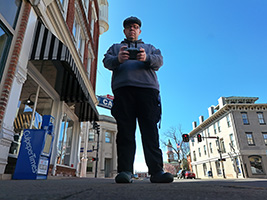Lights in the Foggy Night
This particular photo set, originally taken January 2, 2003, was by no means the first time I’d visited the Roanoke Star and Mill Mountain Park. And it certainly wasn’t the last. I’d had similar conditions up on the mountain before. In fact, my first time ever visiting the Roanoke Star was in a thick fog, though that time was during the day, and the fog also lifted a few hours later. On this particular occasion, the fog was still in place when night fell, leaving the top of Mill Mountain enshrouded in a thick layer of fog. It had also been raining all day, and continued to drizzle as I arrived at Mill Mountain Park, and it was very cold outside the whole time. The Roanoke Star powered up right on schedule, filling the otherwise dark, fogged-in mountaintop with a pinkish glow.
In my first trip to the Roanoke Star with Big Mavica, I was impressed with how the different exposure settings on Big Mavica yielded different results in this exercise. Some shots demonstrate the extent of the thickness of the fog. Others demonstrate how the rainfall factored into the images, as the rain is not only directly photographed, but also photographed in such a way as to demonstrate its effect on the photography environment. Others appear to have been shot in optimal conditions. All the while, I’m standing nearby, holding an umbrella over Big Mavica in an attempt to keep the rain off the camera, while simultaneously trying to keep the umbrella out of the shots.
The entire exercise was a challenge to do, but a fun experience, and I certainly wouldn’t mind doing this type of shoot again one day.
The area beyond the overlook, usually aglow with lights from the city below, today shows a plain view as the fog blocks any potential outward view, and traps in the warm, reassuring glow of the Roanoke Star, out of frame at right.
As a thinner section of fog passes by, it allows a view of the city below, though only for a few moments. The area in the center of this photo is the area around the southern terminus of Williamson Road, where it crosses under US 220.
At long exposures, the fog makes itself evident, as it stymies attempts to photograph the marker in front of the star. At left, the star is out of frame above the image, with the bright lights in the background originating from the adjacent parking area. At right, the star is out of frame to the right.
Taking the exposure down a notch, the marker is visible, though darkened.
The light from the Roanoke Star gives everything a reassuring pinkish glow, even slightly illuminating this stone retaining wall, which faces away from the star.
This image of the star made use of Big Mavica’s flash, which not only reflected off the fog, but also revealed the presence of the rainfall. The rain showed up as unfocused dots on the image.
At a lower exposure setting, except for a slight halo around the star, the fog is nearly invisible, producing a near-perfect image of the Roanoke Star.
However, as the exposure time is increased, the fog becomes more and more evident. It also becomes increasingly evident how much trouble I had with the rain, as it became very difficult to keep the rain off the lens, while simultaneously photographing the subject, and keeping the umbrella and its shadow out of the shot.
The wet observation deck provided an interesting view of the star as a reflection off puddles formed in the various channels in the wood, and also simply off of the wet wood.
Wet asphalt in a nearby area provided a similar effect.
Adjacent to the parking area, a portable toilet exists for the convenience of park visitors. During the day, a “Discovery Center” building is open that contains restrooms, but that facility is closed at night.
Taken along the trail near the star, the fog is thick, as shown in this flash photo.
As viewed from the side and taken at longer exposures, the fog, along with the glow of the outer red neon, seems to create the illusion of the outermost ring being a ring of flame.
And again, taking the exposure down a hair, the fog is hardly noticeable, save for a small halo around the edges.
The Roanoke Star is a fun subject to photograph. But its beauty at night is attained through careful selection of location and exposures.
As learned in a previous encounter with fog, the fog helps provide a sense of depth on the star’s back structure as well. Here, the glow from the star is reflected and scattered by the fog, while the security lighting from the parking lot illuminates the star from behind.
And at really short exposures, the fog is practically nonexistent.
The Roanoke Star is really a beautiful thing, perched at the top of Mill Mountain. Even with its beauty hidden from most of the city by fog, it’s still a wonderful sight to behold, for those who come up to visit it up close.



































